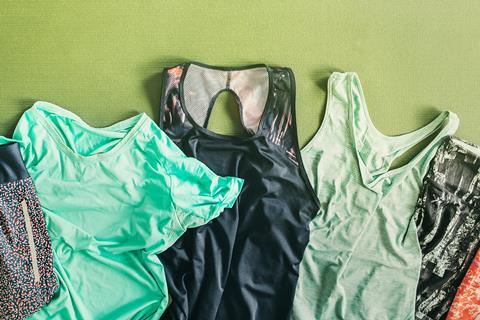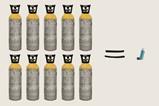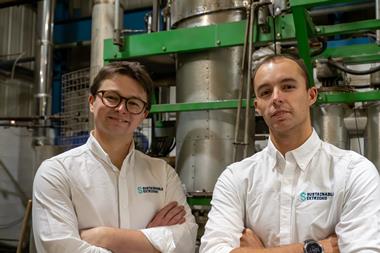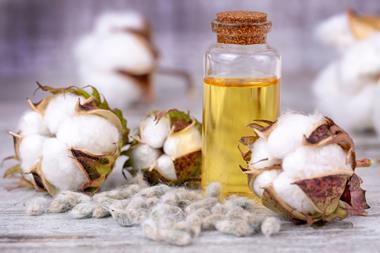Andy Extance reluctantly noses out ways to avoid throwing away smelly polyester sportswear
Even if you’ve never heard the word permastink, if you’re a runner or know one, you’ve likely encountered the smell itself. And if you’ve ever felt the urge to throw away clothes suffering from it, you know the impact it has on the environment: consuming and wasting resources. Permastink refers to an unpleasant odour that won’t wash out of clothes, a smelly, stubborn squatter.
We wash clothing more frequently due to odour formation or even discard it when permastink moves in. Jane Scott, a textiles researcher from Newcastle University in the UK, says that we feel less able to repurpose, reuse, or resell smelly athletics clothing. ‘People would prefer not to even give it to charity; there’s definitely this unique issue around smell,’ she says. ‘These are good quality items. There’s nothing wrong with them – it’s just a smell.’
That contributes to the 1.4 million tonnes of post-consumer textile waste the UK produces each year, with 50% disposed of in household waste bins. Scientists like Scott are therefore studying what causes permastink and looking for ways to reduce it, and its environmental impact.
What causes clothes to smell?
If it smells like your clothes want to get up and walk around, they probably do contain living creatures. When we wear clothes, natural bacteria on our skin attach to, live in and grow on them. These are usually Staphylococcus and Corynebacterium, says microbiologist Angie Sherry from the University of Northumbria, UK. They feed on chemicals in sweat and skin oils known as sebum. When our clothes mix with other people’s, like our families, the bacteria socialise. Microbes move between clothing items, and chemicals they feed on can go with them. In this way, our clothes get their own microbiomes.
Having had their fill, bacteria can excrete strong-smelling compounds, including sulfur-containing ones like thiols and dimethyl disulfides, and fatty acids like propanoic acid and isovaleric acid. As our armpits are warm, moist and rich in nutrients, they host more varied microbes than other places in our bodies. These residents excrete long-chain aldehyde and ketone molecules that oil-loving, hydrophobic fibres like polyester attract. Water doesn’t easily wash this greasy waste out of the polyester clothes the microbes live in.
How is permastink different to normal clothing odour?
Permastink is almost exclusively related to polyester sports clothing. ‘For a long time, bacteria have been blamed for the stronger odours on polyester and the lower odours on cotton or wool fibres,’ says textile scientist Rachel McQueen at the University of Alberta, Canada. ‘But the chemistry of the fibres and the odorous compounds and odour precursors’ is more important, she adds. McQueen’s team asked volunteers to wear T-shirts with polyester, cotton and merino wool patches in their armpits, and then tested their smell chemistry.

Sweat is mostly water but contains oily smell molecules as well as unscented molecules that bacteria will break down into smelly ones. Wool and cotton are hydrophilic or water-loving, absorbing more water but fewer oily smell molecules than polyester. That hydrophilicity also means that laundry liquid enters and loosens attached debris from cotton and wool more easily, cleaning up after any smelly bacterial residents. Wool has open spaces and is more porous than a synthetic fibre, so it can absorb a lot of sweat and can also release odours more easily. 100 percent wool can therefore have much lower odour than other fibres.
Meanwhile, oily odorous compounds may more selectively absorb onto polyester, making it hard to clean up sweat smells and bacterial waste. ‘Polyester can smell stronger and different to our pure sweat odour that hasn’t interacted with polyester,’ McQueen says.
Why doesn’t the washing machine get rid of it?
Today athletic clothes recommend washing at cool temperatures. This uses less energy, and is therefore better for the environment, but doesn’t remove all the bacteria and smell molecules from clothes. And washing machines themselves can be great places for bacteria to thrive. Sometimes they can develop their own microbiomes that make clothing smelly. With polyester being hydrophobic and harder for water to penetrate, smelly molecules and bacteria build up over repeated washings.
What potential solutions are out there?
Some clothes include antibacterial chemicals such as silver chloride, though these don’t always live up to their claims. Other options include treating fabrics with chemicals like zeolites that trap odour molecules and prevent them from reaching our noses.
McQueen’s team has tested such fabrics, finding them to be just as smelly as untreated ones. ‘This could be a quality control issue, perhaps the antimicrobial treatment hasn’t been applied to the fabric in the way it’s supposed to be,’ she says. ‘Or perhaps it’s just not effective. The proof is in the use.’
Worse still, antimicrobial compounds in clothes can leak out and pollute the environment and potentially upset our natural skin microbe balance. ‘You always want to avoid pollution swapping, replacing one problem for another,’ says Sherry.
Sherry, Scott and other researchers have integrated spores of Bacillus bacteria into T-shirts and laundry care products. This project, called Fabriotic is due to complete in September 2025, and involves the University of Plymouth, Newcastle University, the University of Northumbria and consumer goods multinational Procter & Gamble.
Fabriotic creates less-odorous bacterial communities in clothes to more naturally prevent other bacteria settling in and producing permastink. It has prototyped a finish treatment to add to T-shirts and developed probiotic laundry care products. Combining both detergents and fabrics containing bacteria is necessary, says Sherry. ‘An antibacterial fabric would not be compatible with a biotic detergent, and similarly a biotic fabric will need the right care products to keep it performing well.’ The biotic fabric ‘starts to work in the wash basket before the materials are laundered’, she adds.
Regulators already recognise the bacteria in these products as safe, so even if they come off on wearers’ skin, they shouldn’t be harmful. After an ongoing consumer trial, Sherry, Scott and colleagues will analyse the microbiome, textile properties and smell of T-shirts the participants wore.
What are some practical ways to prevent permastink?
Definitely do not start regularly washing your clothes at higher temperatures, say Scott and Sherry. This is worse for the environment and costs more. McQueen suggests wearing natural fibres like wool and cotton. If you do need to remove odorant chemicals, McQueen suggests laundry treatments, typically involving presoaking with active ingredients such as sodium percarbonate and sodium carbonate. Washing clothes more quickly after wear if they tend to build up a permastink could help, she adds.
Sherry encourages us to think of the drying environment too. ‘If you’re drying your clothes at a really high humidity, you’re unlikely to get rid of permastink microbes, because one thing they need to survive is moisture,’ she says. ‘Drying under lower humidity conditions would be advantageous.’ Similarly, it’s important not to leave wet laundry in the machine for too long after washing, to avoid smell-producing microbes taking the chance to party.
The disgust that permastink evokes is a particularly powerful motivator to discard clothing. Thankfully, considering chemistry can help stop bacteria making the molecular mess that causes this perpetual pong.


















No comments yet